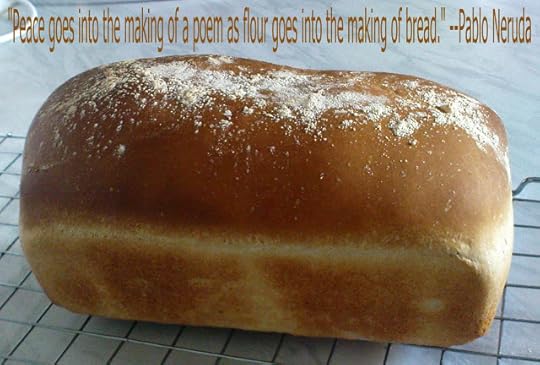Joyce Barrass's Blog, page 56
January 7, 2015
Goatsucker Harvest: Under the Rainbow Hoops of Bram's Duck Decoy
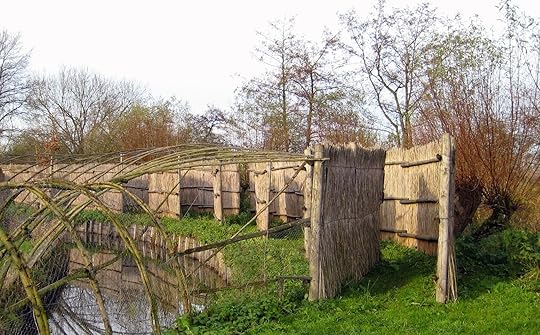 Screens in a duck decoy in nature reserve 't Broek near Waardenburg, the Netherlands (China_Crisis)"Bram gave a low whistle to the dog, that sounded every bit as natural as the calls of the upland waders, bleak and wistful. Then Piper sprang over the succession of low dog-jumps . Further along the pipe, he disappeared from sight, backing away, drawing the wildfowl onward up the pipe. They seemed fascinated by the little hound. Beady eyes winked in the moonbeams shining down. Milky light turned everything into a mysterious pageant in which Thirza, to her utter delight and astonishment, found herself taking her place.
Screens in a duck decoy in nature reserve 't Broek near Waardenburg, the Netherlands (China_Crisis)"Bram gave a low whistle to the dog, that sounded every bit as natural as the calls of the upland waders, bleak and wistful. Then Piper sprang over the succession of low dog-jumps . Further along the pipe, he disappeared from sight, backing away, drawing the wildfowl onward up the pipe. They seemed fascinated by the little hound. Beady eyes winked in the moonbeams shining down. Milky light turned everything into a mysterious pageant in which Thirza, to her utter delight and astonishment, found herself taking her place.It felt so natural to her, she hardly realised how Bram was guiding her with his eye. Thirza found she understood the signals that passed between man and dog, even though the meanings behind the strange names and words were lost in the mists of time."
- (c) Joyce Barrass 2014 - Goatsucker Harvest (Kindle Locations 2627-2630) Kindle Edition.
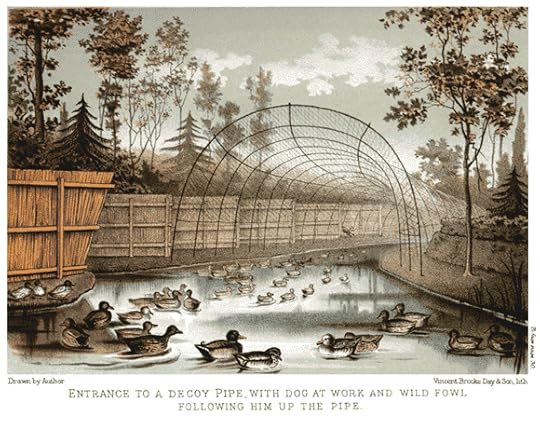
Bram's Duck Decoy or Eendenkooi (Dutch for "duck cage" in the old language of Bram's ancestors who were decoymen before him), is far out on the marshes and peat bogs, somewhere on the misty edges of the novel's level landscape, between Yorkshire and Lincolnshire.
The villagers of Turbary Nab avoid the Decoy now. Some have forgotten its whereabouts. Some never know them. Others dare not venture out in that direction, where the unpredictable fen-lights, the ignis fatuus, the deceptive glow in the dark of the atmospheric ghost lights flicker over the boggy marshes of the peat fen and moors that are Bram's home, leading the unwary off the beaten track to a fate beyond dread.
Traditional Duck Decoys were devices used to entice wildfowl, for food or in latter days for ringing, constructed with a central pond with between one and eight tapering, radiating arms, surrounded by wooden hoops and netting. These are the "pipes" after which Piper, Bram's faithful kooikerhondje is named (click link for my blogpost about him). First recorded in Bram's ancestral Netherlands in the sixteenth century, the idea of the duck decoy was imported to the fens and wetlands of Britain.
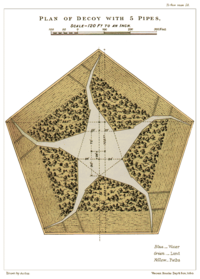 "Ducks bobbed on the star shaped pool under the nets at sunrise. The little teal, its wing shattered by a farmer's gun over a copse in Crowle, had been drawn here by the misty rainbow light arching between the hoops of the old duck decoy. It swam searching along each arm of the decoy for a place to rest."
"Ducks bobbed on the star shaped pool under the nets at sunrise. The little teal, its wing shattered by a farmer's gun over a copse in Crowle, had been drawn here by the misty rainbow light arching between the hoops of the old duck decoy. It swam searching along each arm of the decoy for a place to rest."(c) Joyce Barrass 2014 from Goatsucker Harvest (Kindle Locations 808-810) Kindle Edition.
No killing, hunting or even ringing in Bram's Decoy, though, as the little Teal will discover. Under the rainbow hoops, Bram's lore is the mysterious "Reversal of Ravage", the "Omkering van Schade" passed down to him from his forebears, who came over with Cornelius Vermuyden in the days of King Charles to work on The Great Drainage of the flooded fens.
Decoy ducks were traditionally carved from wood or cork and stained in plumage colours to fool the wildfowl. Bram's decoy ducks are crafted in quite another way, so much more than the sum of their driftwood and clockwork parts.
But in the mid-Victorian world of "Goatsucker Harvest", in the wake of the Industrial Revolution, these secrets are much sought after by others. Those for whom the fragile environment of the moors and marshes means nothing compared to profit and fame. Soon, for the inhabitants of Turbary Nab, nothing can ever be as it was.
Watch a YouTube video of a modern Dutch decoyman & his kooikerhondje (just like Piper in my novel!)
More footage of a decoyman & dog in Holland (1974)
Discover the mysteries of "Goatsucker Harvest" for yourself on Kindle
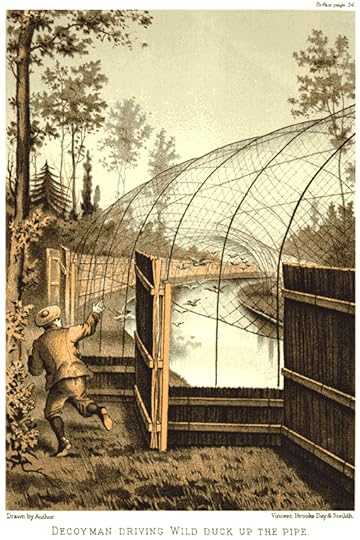
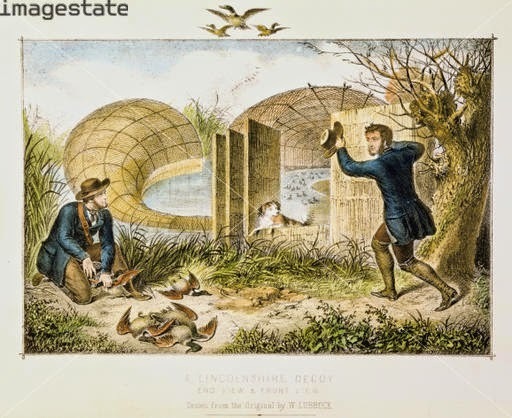
Published on January 07, 2015 08:57
January 6, 2015
Goatsucker Harvest: "So, what's a Goatsucker, when it's at home?"
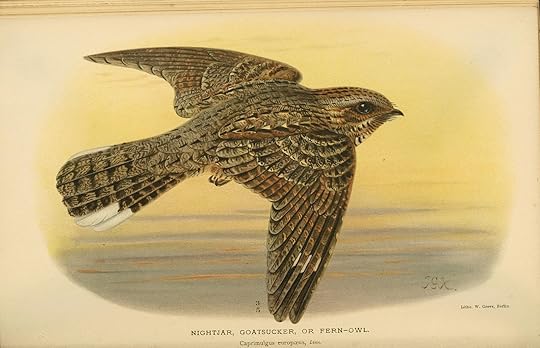 Nightjar, Goatsucker, or Fern-Owl, Caprimulgus europaeus (Lithograph from Painting by J G Keulemans in 'Coloured Figures of the birds of the British Islands 1885-1897) "Why "Goatsucker Harvest"?"
Nightjar, Goatsucker, or Fern-Owl, Caprimulgus europaeus (Lithograph from Painting by J G Keulemans in 'Coloured Figures of the birds of the British Islands 1885-1897) "Why "Goatsucker Harvest"?""Such an intriguing title - can't wait to read it!"
"What's a Goatsucker, when it's at home?"
"I've got to ask....'Goatsucker Harvest'... very unusual to say the least, where did it come from!!!!???"
This question's the one I get asked the most when people hear the title of my novel.
So here's the lowdown!
The honest answer is the title itself is straight out of my imagination. I love what it makes me think and feel, about a dusky world out on the peatlands and lowland moors near my ancestral home in South Yorkshire, where the Nightjars fly, chirring their unearthly song and clapping their wings in the twlight, laying their eggs in the summer under the full moon.
I wonder if anyone else recalls a local programme on TV a few years ago in Yorkshire, with Look North weatherman, Paul Hudson, flying in a microlite to discover the The Seven Natural Wonders of Yorkshire & Lincolnshire ? Paul explored local treasures like Malham Cove, Hornsea Mere, Spurn Point and the bird-thronged cliffs at Flamborough (setting for my next novel, "The Clockwork Climmer.").
But what caught my imagination most of all, was his visit to Thorne & Hatfield Moors, part of the Humberhead Levels and the largest area of lowland peat bog in Britain. There Paul was shown how it is possible to stand very still on the Moors in the dusk of evening, clapping your hands above your head, to imitate the sound of the Nightjar's wing-claps. If you are very fortunate, a real life Nightjar will come out of the gloom and fly over your head, emitting its eerie, almost other-worldly cry, so distinctive and unlike any other local bird.
Nightjars chirring at dusk in this YouTube video
That image stuck with me, finding its way into the story, mixed with so many other ideas from the years I'd spent walking the land around Thorne, Hatfield Woodhouse, Stainforth, Fishlake, Moorends, Auckley, Blaxton, Finningley and that part of Doncaster that in places, seems to have an alien microclimate and history all of its own. I'd always been fascinated not just by the lives of my own ancestors in these parts, but by the geography, history, flora and fauna of the places they had called home.
So this inspired the setting for "Goatsucker Harvest", with Bram a central figure, unlocking the mysteries of these hidden worlds with his sensitivity and family connections as marshman, decoyman and pinder near Turbary Nab (in the real world, Fishlake Nab was an anchor for the imaginary topography of the landscapes painted in the novel). Bram alone has the local knowledge of the wildfowl, plants and earth secrets with which Thirza becomes involved.
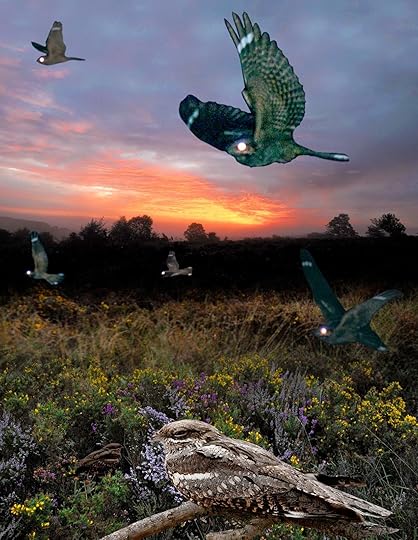 European Nightjar from the Crossley ID Guide Britain & Europe
European Nightjar from the Crossley ID Guide Britain & EuropeThe Nightjar has many folk names, including Goatsucker, because people used to think its nocturnal habits included sucking the udders of goats dry in the night. The milk connection is also echoed in one of its other nicknames "Churn-Owl", or "Fern Owl" for its chosen habitat among the bracken. The Nightjar features in the book in several forms, both real and mechanical. It becomes significant as the story unfolds. The atmosphere of the book will draw you into this uncanny world as soon as you set foot there.
I also interwove the other understanding of "Goatsucker" into my tale. In folklore originating in the Americas, there is belief in sightings of a strange monstrous creature, the size of a small bear, that is supposed, according to various reports, to have the habit of attacking livestock and sucking their blood. Events in the book raise the hackles of the inhabitants of Turbary Nab, wondering whether such things might be true.
So, that's Goatsucker. But "Harvest"?
I chose "Harvest," as the novel's action leads up to a dramatic climax that happens on the day of the village harvest festival in early October. Harvest also refers to the way in which seeds sown, actions and intentions for good or ill, flower and fruit into a harvest of consequences, cause and effect, a final outcome for the different characters. Often quite a different "harvest" from the one they anticipated or hoped for.
Goatsucker Harvest.
But when the sickle falls, will the reaping be relief or regret?
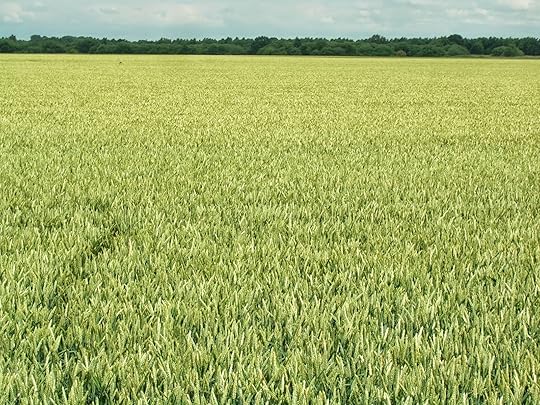 Corn field near Thorne Moors
Corn field near Thorne Moors
Published on January 06, 2015 10:14
January 4, 2015
Goatsucker Harvest: Piper the Kooikerhondje, the Decoy Dog with a difference

Unless you've loved one, I guess you haven't googled what a Kooikerhondje looks like. A Kooiker Hound. A Dutch Decoy Dog. So here he is - Bram's Piper in Goatsucker Harvest looks something like this fella. A small spaniel, of Dutch ancestry, like Bram himself.
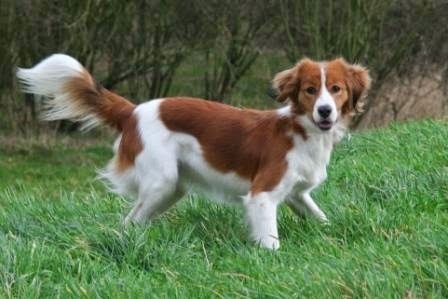
Painted by Rembrandt and below in the foreground on a cushion in this painting by Jan Steen.
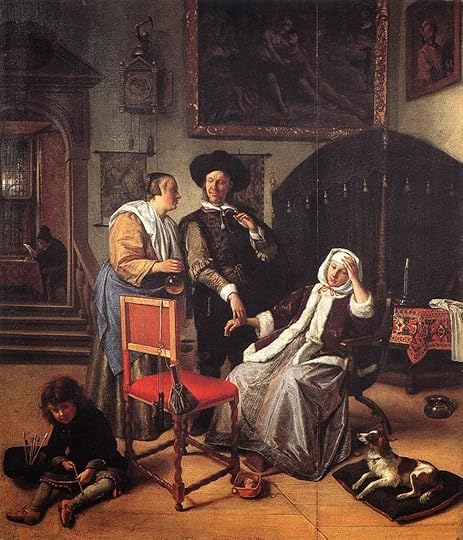 Jan Steen "Doctor's Visit" oil on panel, 1661-2, Victoria & Albert Museum (Kooikerhondje in right foreground on cushion)
Jan Steen "Doctor's Visit" oil on panel, 1661-2, Victoria & Albert Museum (Kooikerhondje in right foreground on cushion)A faithful little working dog, bred to work in harmony with his human, entrancing wildfowl at the eendenkooi (duck cage). Piper's a bit special, as you'll discover, inseparable from Bram in his stewardship of the peat moors, at the decoy or in the pinfold. Almost human, you might say.
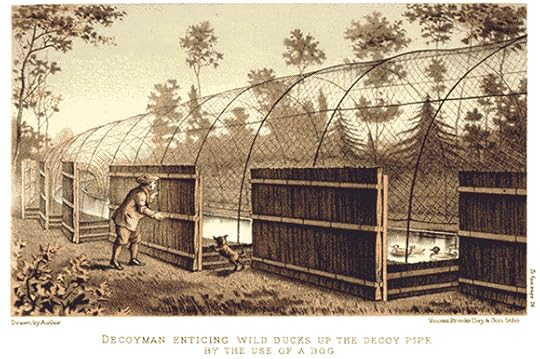
Published on January 04, 2015 14:33
Goatsucker Harvest: Sir William Cubitt & Doncaster Railway Plant Works
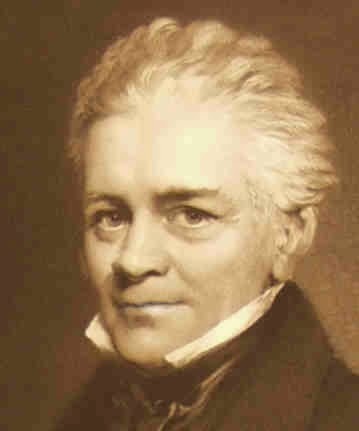 Sir William Cubitt (1785 - 1861) Civil EngineerMost of the characters in "Goatsucker Harvest" are inspired by the author's own ancestors or wholly fictional figures from the mid-century Victorian Yorkshire they inhabit. The sole exception is Sir William Cubitt, a real live figure from England's past. In the book, he appears in the breathtaking breakneck climax of the story, when someone who was once a fan of his engineering talents turns against him in a tidal wave of jealous vengeance and focussed fury.
Sir William Cubitt (1785 - 1861) Civil EngineerMost of the characters in "Goatsucker Harvest" are inspired by the author's own ancestors or wholly fictional figures from the mid-century Victorian Yorkshire they inhabit. The sole exception is Sir William Cubitt, a real live figure from England's past. In the book, he appears in the breathtaking breakneck climax of the story, when someone who was once a fan of his engineering talents turns against him in a tidal wave of jealous vengeance and focussed fury.Sir William, in the plot of the book, returns to Doncaster as an esteemed guest of honour to give a speech at a presentation at the famous railway Plant Works in the town. He little suspects that he is in the cross-hairs of a deadly and death-dealing invention devised by the man who now counts him as his bitterest enemy. Can Bram warn Sir William in time to save his life, the lives of many more innocent citizens and the steam and locomotive heart of Doncaster itself? Only Goatsucker Harvest has the answers!
The historical Sir William, son of a miller in Norfolk, was a man of many talents during the heady days of the Industrial Revolution that transformed Victorian England and which suffuses the novel, always in tension with the natural world.
He designed the patent windmill sails that bore his name. He designed the treadmill widely used in Victorian prisons and on which the author Joyce's great great great grandmother's cousin, the Sheffield Chartist hero Samuel Holberry died in York Castle in 1842.
Known for the accuracy and precision of his patterns for the iron castings of machinery, Cubitt was appointed chief engineer of the world-famous Crystal Palace, erected in London in 1851 and was made president of the Society of Civil Engineers in the years leading up to the action of the novel.
He worked on canals, too, designing bridges and locks, Thirza's heartland and home in "Goatsucker Harvest". His designs for docks and harbours were in demand in the UK and on the continent, including the Oxford Canal and Liverpool Junction Canal and he made improvements to rivers like the Severn.
He left a living monument to his genius in the world of Victorian railways, the South Eastern and the Great Northern. An example of his work, the Welwyn Viaduct, is still standing magnificent in 2015.
He and his equally talented son, Joseph Cubitt, designed and built the original buildings of the Plant Works in Doncaster, birthplace of great locomotives like The Flying Scotsman. This is what draws the fictionalised Sir William into the drama of 'Goatsucker Harvest', towards the end of his illustrious career.
In the world of history we call "real life," Sir William died an old man in 1861. In the world of fiction, in Goatsucker Harvest's 1855 world of shifting shadows, phlogiston, peat, ball lightning, "chemic what-me-nots" as Lucas would put it, steampunk and subterfuge, you'll have to explore and enjoy the story to see if Sir William's fictional alter ego is afforded the same luxury!
 Doncaster Plant Works pictured in 1957 (NRM)
Doncaster Plant Works pictured in 1957 (NRM)
Published on January 04, 2015 04:30
January 2, 2015
Goatsucker Harvest: Jem rides into the Valley of Death - Charge of the Light Brigade
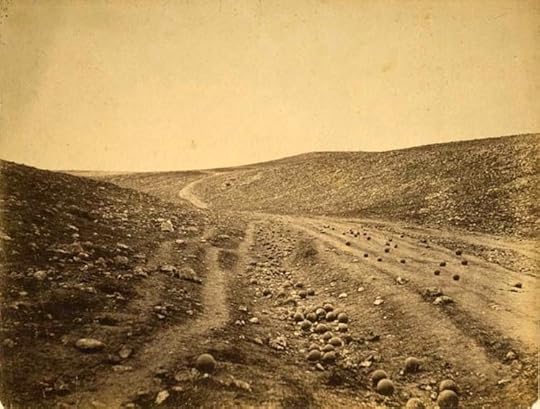 Cannonballs strewn up the Valley of Death after the Charge of the Light Brigade
Cannonballs strewn up the Valley of Death after the Charge of the Light Brigade(Photo by Roger Fenton, Victorian photo journalist, 1855)In "Goatsucker Harvest", Jeremy "Jem" Kitson is first seen in the hospital in Scutari, fresh from fighting in the Crimean War, taking part in the horrific "Charge of the Light Brigade" with his regiment, the 11th (Prince Albert's Own) Hussars, the "Cherry Pickers", on his beloved horse, Samphire. Suffering shellshock and what we would perhaps now call PTSD (Post Traumatic Stress Disorder), Jem's ordeal casts a long shadow through the events of the novel, though all, as ever, is not what it seems. Tennyson's famous poem, penned and published just weeks after the events it describes, also echoes through the book with its chilling rhythms of hopelessness and heroism:
"Half a league, half a league,
Half a league onward,
All in the valley of Death
Rode the six hundred.
"Forward, the Light Brigade!
"Charge for the guns!" he said:
Into the valley of Death
Rode the six hundred.
"Forward, the Light Brigade!"
Was there a man dismay'd?
Not tho' the soldier knew
Someone had blunder'd:
Theirs not to make reply,
Theirs not to reason why,
Theirs but to do and die:
Into the valley of Death
Rode the six hundred.
Cannon to right of them,
Cannon to left of them,
Cannon in front of them
Volley'd and thunder'd;
Storm'd at with shot and shell,
Boldly they rode and well,
Into the jaws of Death,
Into the mouth of Hell
Rode the six hundred.
Flash'd all their sabres bare,
Flash'd as they turn'd in air,
Sabring the gunners there,
Charging an army, while
All the world wonder'd:
Plunged in the battery-smoke
Right thro' the line they broke;
Cossack and Russian
Reel'd from the sabre stroke
Shatter'd and sunder'd.
Then they rode back, but not
Not the six hundred.
Cannon to right of them,
Cannon to left of them,
Cannon behind them
Volley'd and thunder'd;
Storm'd at with shot and shell,
While horse and hero fell,
They that had fought so well
Came thro' the jaws of Death
Back from the mouth of Hell,
All that was left of them,
Left of six hundred.
When can their glory fade?
O the wild charge they made!
All the world wondered.
Honour the charge they made,
Honour the Light Brigade,
Noble six hundred." - Alfred, Lord Tennyson 'The Charge of the Light Brigade' (1854)
This photo was taken after the Charge in 1855, the year the novel is set, by Victorian photo journalist Roger Fenton, showing the cannonballs still strewn along the infamous "Valley of Death".
Published on January 02, 2015 02:41
Goatsucker Harvest: Bram & Piper & the Decoy
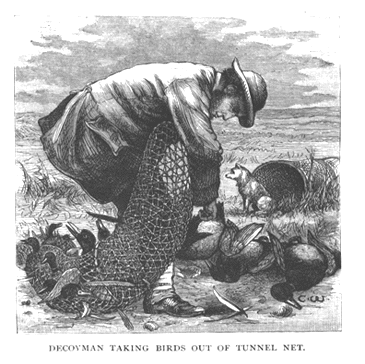 Do you picture characters in your head and your heart as you read a book? I confess as I wrote "Goatsucker Harvest" I fell a bit in love with Bram, whose sensitivity to nature, creatures, landscape and intuitive caring is everything I care about. Here's a picture of a real-life decoyman and his dog (like Bram & Piper in my book). Of course, Bram's decoy is quite the opposite of the regular wildfowl-trapping kind!
Do you picture characters in your head and your heart as you read a book? I confess as I wrote "Goatsucker Harvest" I fell a bit in love with Bram, whose sensitivity to nature, creatures, landscape and intuitive caring is everything I care about. Here's a picture of a real-life decoyman and his dog (like Bram & Piper in my book). Of course, Bram's decoy is quite the opposite of the regular wildfowl-trapping kind! I first saw a duck decoy in Doncaster Museum and the spark of an idea for Bram was born. But unlike duck trappers of old, Bram lives by a different principle: the ancient lore of his own people, descendants of the Dutch drainage engineers who came over in the 17th century with Cornelius Vermuyden to drain the peat bogs in Doncaster area and the Fens of East Anglia. His mission is the "Reversal of Ravage", "Omkering van schade" passed down through Bram's ancestral line. But there are those on the horizon who have other ideas.
Uncover the mysteries of the South Yorkshire peatland moors and meet Bram for yourself in GOATSUCKER HARVEST (Kindle Edition)
Published on January 02, 2015 02:27
December 29, 2014
Goatsucker Harvest: stunning settings beyond Doncaster the unwary traveller seldom dares to explore!
 The Stainforth & Keadby Canal at Thorne
The Stainforth & Keadby Canal at Thorne
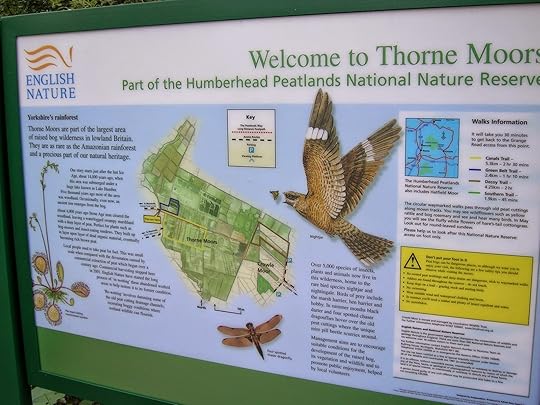 Information Board by English Nature showing the Nightjar (aka "goatsucker") to lure you onto wonderful Thorne MoorsI hope many of you are already enjoying exploring the haunting setting of "Goatsucker Harvest" in your mind's eye. I know some of you are, even though it's not been published for a whole week yet!
Information Board by English Nature showing the Nightjar (aka "goatsucker") to lure you onto wonderful Thorne MoorsI hope many of you are already enjoying exploring the haunting setting of "Goatsucker Harvest" in your mind's eye. I know some of you are, even though it's not been published for a whole week yet!I know because I've already been chided for interfering with people's Christmas preparations, for encroaching on people's sleep late into the night with Kindles under the sheets and for lowering people's body temperature with the description of life on a Humber Keel in the middle of an icy February in that first chapter!
As soon as I first ventured out onto Thorne Moors, on the Humberhead Levels, back in the summer of 2005, my imagination was possessed and senses thrilled by this fragile and extraordinary wilderness wonderland. It crept into my psyche, whispering in the voices of my ancestors who lived and died around these bleak peatlands stretching for miles in every direction around Doncaster, to Thorne, Fishlake, Stainforth, Hatfield, Crowle, Epworth, Belton, Goole and Rawcliffe to the north.
Many of my people, like Thirza Holberry's family in "Goatsucker Harvest", were keelmen and women, mariners and water gypsies, born to live and work on the boats that came inland on the Stainforth and Keadby Canal, the River Don and the South Yorkshire navigation waterways that zigzag across the peaty dykes and warp drains, joining this weird flat landscape to the restless North Sea.
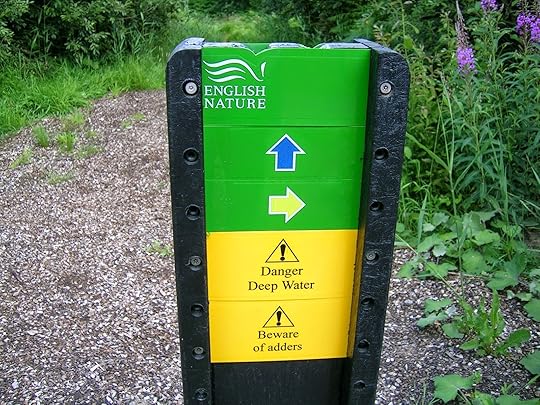 Beware of adders - a warning Thirza learns to heed from Bram in "Goatsucker Harvest" chapter 9!Other characters in the book share their names, their sensibilities, their occupations with my own people who scraped a living from this forgotten paradise of Northern England, still the largest area of raised peat bog wilderness in lowland Britain, land partially reclaimed by the Dutch drainage engineers under Sir Cornelius Vermuyden in the 17th century.
Beware of adders - a warning Thirza learns to heed from Bram in "Goatsucker Harvest" chapter 9!Other characters in the book share their names, their sensibilities, their occupations with my own people who scraped a living from this forgotten paradise of Northern England, still the largest area of raised peat bog wilderness in lowland Britain, land partially reclaimed by the Dutch drainage engineers under Sir Cornelius Vermuyden in the 17th century.This bizarre backdrop is home to as many rare and precious creatures and plants as you will find anywhere in the UK: nightjars (the "goatsuckers" of the title), adders, lizards, dragonflies, cottongrass and sphagnum mosses. Somewhere in the region of 4,000 animal and plant species live here, including 25 of the rarest of all found in Britain, like the giant raft spider and the mire pill beetle.
If you aren't able to come to the moors today, why not explore with me in your wildest imagination? The landscape of "Goatsucker Harvest" is waiting for you, seldom travelled by the faint of heart, full of hidden treasures and unnerving mystery, be it unseen menace or life-enhancing transformation.
 Purple Vetch and Bracken on Thorne Moors
Purple Vetch and Bracken on Thorne Moors
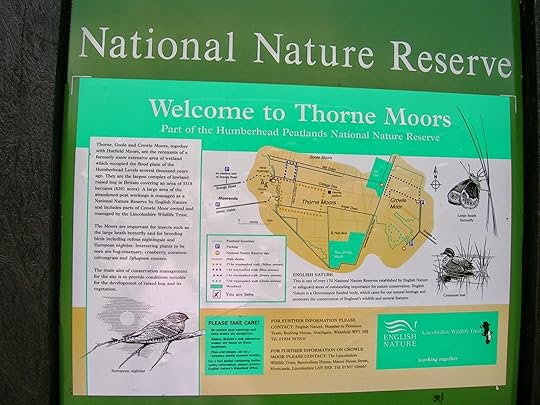 Noticeboard showing the Nightjar (aka "goatsucker") on Thorne Moors [English Nature]
Noticeboard showing the Nightjar (aka "goatsucker") on Thorne Moors [English Nature]
 Path towards Thorne Moors: the drama of the Levels
Path towards Thorne Moors: the drama of the Levels
 Peatland path across Thorne Moors
Peatland path across Thorne Moors
 A wonderfully wet wilderness'GOATSUCKER HARVEST' by Joyce Barrass is available here on Kindle
A wonderfully wet wilderness'GOATSUCKER HARVEST' by Joyce Barrass is available here on Kindle
Published on December 29, 2014 08:02
December 23, 2014
Goatsucker Harvest - launched and afloat!

****UPDATE**** Downloadable now at a modest £1.97 or even £0.00 if you're signed up for Kindle Unlimited Goatsucker Harvest on Amazon.co.uk
Previously...Here's the reason I've been a bit quiet on the bloggery front these past many months. Thanks for bearing with me, you lovely folks! Having been housebound for the best part of a year, I've finally got my debut novel ready for publication. As I type, my quirky but house-trained "baby" is "in review" on Amazon Kindle Direct Publishing on the KDP Select. Even managed to upload my photo of a Humber Keel (on which I happened to be sailing at the time) as the cover photo (pictured above).
The only 4 words KDP queried as possible spellchecks when I uploaded were:
"Esq"
"sprattle beam"
"windshaft"
and
"Yackoop!"
None of which were actually wrong. It'll all make perfect sense to you, dear readers, once you're on the voyage!
Apparently, my novel should be available for you to download on Kindle stores worldwide within the next 12 hours. *crosses all available digits*
So what can you expect?
Well, it's a historical fantasy, set in 1855 on the peat moors and canals of South Yorkshire, stamping ground of many of my ancestors, as you'll know by now from this blog. Expect exploding windmills, mysterious flying machines, water gypsies, the Charge of the Light Brigade, the Humberhead Peatlands, Doncaster Railway Plant Works, Wickersley Quarry, Hull Docks, phlogiston-powered stilts, duck decoys, cattle mutilations, tall dark handsome strangers, ball lightning, Humber Keels, left-handedness, clockwork birds, a traumatised hussar, some very twisted inventions, a social-climbing Mrs Malaprop, a squiffy toff landowner, a genealogist village wisewoman, an impossibly cute half-human Kooikerhondje dog, an acrophobic miller's wife, thrills, spills, drama, comedy, mystery, intrigue, romance, a flying Dutchman and some Yorkshire grit.
Who could ask for anything more? Well, you can. Cos there's another novel in the pipeline.
I love to hear from readers, so please let me know what you enjoy about it and maybe what you don't. What you'd like to see more of or what you'd maybe rather not see again!
Hope you'll enjoy the ride!
Published on December 23, 2014 07:40
August 2, 2013
ASHEN
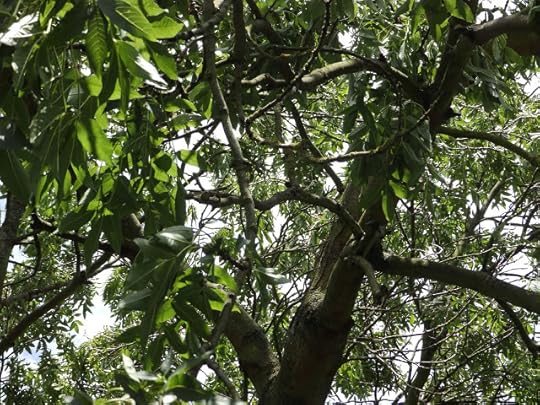
ASHENNoctilucent crownDigit dither in bluest breezeSummer spenderOf unresting still
Nithered in dusk's gownHolding owl in finger squeezeWinter welcomerQuiesce to chill
Your keys hold all pendulaHushing the clockwork,Finger on lip of the stream;Keys fan, fair flutterer,Ogham misspellingThe drift and the dream
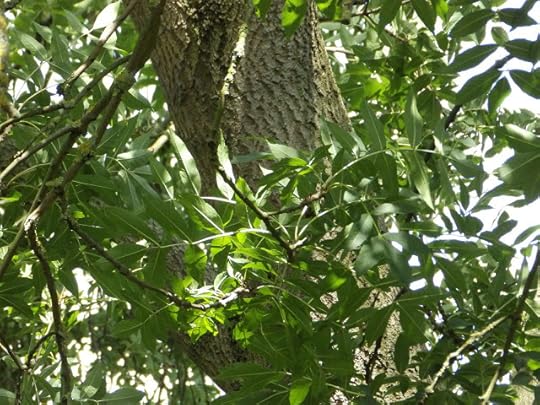

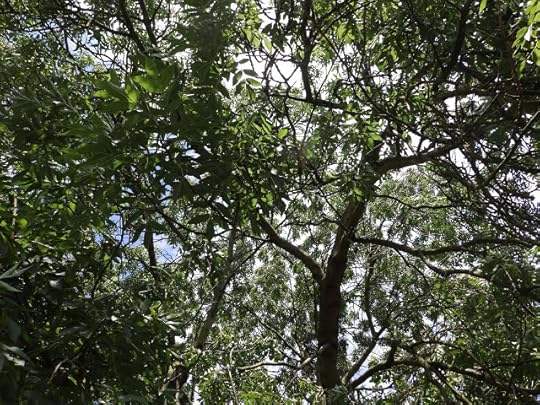


Published on August 02, 2013 06:41
April 30, 2013
Peace and Flour
Published on April 30, 2013 14:42

